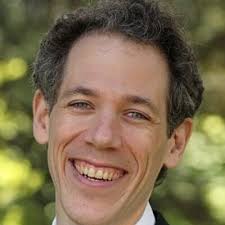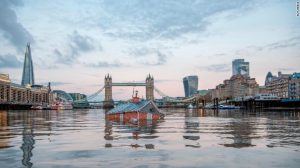What cities, deltas or whole countries will be lost? Scientist Benjamin Krauss at Climate Central joins us. British expert Dr. Jonathan Bamber on new high sea predictions. Brand new coastlines are possible by the end of this century. And a murky worry for all is something called “Antarctic instability”.
We journey into the science of past and future. I’m Alex Smith. You may not find inflatable life jackets under your seat this trip.
Listen to or download this Radio Ecoshock show in CD Quality (57 MB) or Lo-Fi (14 MB)
VENICE HAS FLOODED!
Just two weeks ago we had two guests explain the wet prospects for the grand city of Venice.
Our Italian expert Luca Muscara now writes: “Our interview was somehow prophetic: last night there has been a catastrophic flooding. With winds up to 100 m/h the tide reached 187 cm above mean sea level [over 6 feet!!] and 82% of the historic city went under water.
It’s been the second worst one ever on record, only 7 cm below the top worst one of 1966.
Public transport was entirely suspended, some of its boats sunk, and hundreds broke their mooring and went adrift, while hundred of trees fell, there were extensive blackouts throughout most of the city.
We are only beginning to survey damages, which are huge, while a 160 cm flood [over 5 feet] is announced for 10.30 am and more to come.”
The Mayor of Venice blames climate change for the highest tide in 50 years.
Here is another good article about the new floods in Venice and what is at stake.
AUSTRALIA IS BURNING!
In early October, I interviewed Greg Mullins, the retired fire and emergency commander for New South Wales in Australia. He warned fires had already started early, and fire conditions were “catastrophic”.
Sure enough parts of Australia are burning this week. It’s monumental. Commissioner Shane Fitzsimmons from the New South Wales Fire and Rescue Service says they can no longer try to save homes from these super blazes:
“Suppression is futile. The focus is on life safety and life protection. We will not guarantee and cannot guarantee a fire truck at anyone’s house or an aircraft at anyone’s house. We can’t guarantee a knock at the door. And we certainly can’t guarantee an emergency alert coming through on your phone to give you a warning...”
Sure it’s easy to be prophetic – when climate science can already see it coming! Stay tuned to Radio Ecoshock.
************************************************************************************************************************
IT IS TIME TO HELP ME KEEP RADIO ECOSHOCK ON THE AIR! PLEASE DONATE.
You can also help the program with your donation, or by subscribing as a monthly donor. It’s fast and easy, but your help makes it possible to keep offering all Radio Ecoshock programs free, and advertising free. Radio stations do not pay me anything – they get it for free too. So really it is blog readers and listeners like you who make this show possible. Please help me if you can here.
************************************************************************************************************************
In this Radio Ecoshock special on the new future of rising seas: Two scientific experts explain previous gross underestimates of just how many people will be flooded out. It could be six times as many, hundreds of millions.
At the high end, at our current rate of emissions, almost one in seven people on the planet will be facing salt water in their homes, businesses, streets and farms at least once a year. Whoever is wealthy enough and has the foresight must begin construction of massive surge defenses now, this year. But or millions of farmers and city dwellers, retreat will be the only option.
JONATHAN BAMBER: ICE AND RISING SEAS
Astounding new science finds the amount of land and people exposed to sea level rise has been wildly underestimated. At least 100 million more people will be flooded out this century. A lot of that new sea water is coming from melting ice at the Poles. Professor Jonathan Bamber is a specialist in the great ice melt, providing data used by scientists around the world. Dr. Bamber is from the Bristol Glaciology Centre at UK’s University of Bristol.
 Dr. Johanthan Bamber, UK
Dr. Johanthan Bamber, UK
Listen to or download this 28 minute interview with Jonathan Bamber in CD Quality or Lo-Fi
I wanted to get Dr. Bamber’s assessment on the new study of real coastal sea level from Climate Central. He’s published on the subject and attended the presentation by lead author Scott Kulp at the AGU held at the end of 2018. We got a good outside explanation.
But these to the main course. Even when we do get a better estimate of what land is really within 2 meters, or about 6 feet of the current sea level – we need to know how much that sea level will change and by when. That is where Bamber’s work contributes a lot. He specializes in providing “bed elevation datasets” for places like Greenland and regions in Antarctica. His data is used by scientists all over the world.
In 2013, Jonathan Bamber published the paper “An expert judgement assessment of future sea level rise from the ice sheets” in Nature Climate Change. He explains how “expert judgement assessment” works. That 2013 paper, with WP Aspinall, said what many of us thought: IPCC reports were underestimating future sea level rise. But it’s interesting. In 2013, the best judgement from a group of the world’s best experts put the high end risk of global mean sea rise at 1 meter by the year 2100. But in the 2019 paper, that worst-case-but-possible scenario goes twice as high, to 2 meters (over 6 feet of sea level rise). I ask Jonathan why.
Here is the new paper we talk about.
“Ice sheet contributions to future sea-level rise from structured expert judgment” Jonathan L. Bamber et al (including Michael Oppenheimer and Robert Kopp). It was published April 8 2019 in PNAS, the Proceedings of the National Academy of Sciences (with stellar names like Stefan Rahmstorf as editor and with the blessing of Joachim Schellnhuber.)
“ANTARCTIC INSTABILITY”
Lately various experts, including Robert M. DeConto, suggest ice sheets in Greenland and certain regions in Antarctic could melt or even fall apart much faster than we have experienced so far. In 2016, DeConto wrote: “Antarctica has the potential to contribute more than a metre of sea-level rise by 2100 and more than 15 metres by 2500, if emissions continue unabated. In this case atmospheric warming will soon become the dominant driver of ice loss, but prolonged ocean warming will delay its recovery for thousands of years.”
ONE ADDED THOUGHT: We hear about Antarctic tourism. You don’t need to visit Antarctica. It’s coming to you – or at least to maybe a billion humans living along the low coasts…
==================================================================================================
BENJAMIN STRAUSS: HUNDREDS MILLIONS MORE AT RISK TO RISING SEAS
“If our findings stand, coastal communities worldwide must prepare themselves for much more difficult futures than may be currently anticipated.”
With climate, there is shocking news, and super-shocking news. We just learned that many more humans could be flooded out by rising seas – hundreds of millions more people than we thought. Published October 29, 2019, the new study is titled “New elevation data triple estimates of global vulnerability to sea-level rise and coastal flooding”.
The authors are Scott Kulp & Benjamin Strauss, both from the non-profit news source Climate Central. Our guest Dr. Benjamin Strauss is CEO and Chief Scientist for Climate Central.

Dr. Ben Strauss, Climate Central
Listen to or download this 28 minute interview with Benjamin Strauss in CD Quality or Lo-Fi
The new study is: “New elevation data triple estimates of global vulnerability to sea-level rise and coastal flooding” as published in Nature Communications October 29, 2019. It is open access to you can read the whole paper for free (and you should!)
In the interview, we talk about the inaccuracies generated when using a tool called Shuttle Radar Topography Mission. That NASA satellite project could only estimate land elevation as a kind of bounce-back signal. So in a forested area, the tops of the trees might be taken as ground level (large error!). Or city roof-tops could be considered street level.
Kulp and Krauss worked out a new Digital Elevation Model (DEM) which really works well for the coastlines, where we need them most to project risings seas. When they added info for urban areas, vegetation, and many other cross-checking features, the authors found hundreds of million more people live with 2 meters of sea level right now. Two meters is the upper end of sea level according to a process called “Expert Structured Judgement” (see my first interview, with Johnathan Bamber). I guess that is the worst case scenario, although it might be worse than that with surprises yet to come this century.
At least now there can be more accurate planning, where people plan at all. The new lands now discovered most in danger are in southeast Asia – Vietnam, the Philippines, Bangladesh, India, and Indonesia. But China has more people exposed to serious annual floods (at least) than anyone one else. Some of China’s big industrial production zones are set up to flood.
So what? Remember when Bangkok and surrounding lands flooded a few years ago? It turned out that pretty well all of the world’s hard drives came from there. There was a shortage that hit silicon valley. So when Chinese production zones go under, you can expect that to hit products you buy and depend on right now. It’s a small inter-connected world.
Climate Central has an interactive map of their new results here.
From the various projections of sea level rise, the authors choose one close to the IPCC prediction (K14) and one which allows for more rapid sea level rise (K17). The more rapid possibility involves a faster melt from Antarctica, and cites this paper:
DeConto, R. M. & Pollard, D. Contribution of Antarctica to past and future sea-level rise. Nature 531, 591–597 (2016).
THINGS LEFT OUT: MIGRATION AND POPULATION
Millions are still moving toward the coasts, and we expect to add another billion people within a decade. But even these new higher exposure counts may still be underestimates because new models do not yet include migration or population growth. Those are pretty big figures to leave out.
For that matter, as the authors point out, we are not even sure how many people live where. Census data is not accurate in many countries. Not only do we now really know how much land is liable to flood, we don’t really know how many people live there. I get the feeling we are still feeling our way around in the darkness.
The largest single incursion by the sea I can remember is the 2004 tsunami that hit a circle of Asian countries after an earthquake in the Indian Ocean. Over a quarter million people in 14 countries died. But I did not see anything about Tsunamis in this new paper. All this is yet to come. “Efforts to integrate projected population growth, migration, economic development and coastal defenses into ECWL exposure projections have begun“… the authors say. But one thing we know for certain from this Climate Central science: current estimates were wildly low, and are likely to only go higher.
RESULTS FROM THE PAPER:
“For one moderate future scenario, sea levels projected by 2050 are high enough to threaten land currently home to a total of 150 (140–170) million people to a future permanently below the high tide line, or a marginal increase of 40 (30–60) million. Total and marginal exposure each rise by another 50 (20–90) million people by end of century. A total of 360 (310–420) million people are on land threatened by annual flood events in 2100, or an extra 110 (60–170) million beyond the contemporary baseline. This case reflects greenhouse gas emissions cuts roughly consistent with warming of 2 °C (emissions scenario RCP 4.5) and assumes a mostly stable Antarctic (sea-level model K14).
In the case of Antarctic instability, a total of 300 (270–340) million people today live on land indicated as vulnerable to an annual flood event by mid-century, rising to as many as 480 (380–630) million by 2100. These values represent marginal increases of 50 (20–90) and 230 (130–380) million from the present, respectively. All 90% CIs given originate from uncertainty in sea-level projections.”
SEA LEVEL RISE IN AMERICA
Even in America, Krauss and Scott Kulp say: “sea-level rise this century may induce large-scale migration away from unprotected coastlines, redistributing population density across the country and putting great pressure on inland areas.”
That doesn’t sound good for high-priced coastal real estate, or the big banks who carry those mortgages. David Burt, the man who predicted the 2008 financial crisis and famously got out, now tells MarketWatch that climate change will break the housing market. Is it possible that climate damage could bring on the next great Depression?
This new study brought up two emotions in me. The first was almost anger: why were we not told sooner? The second was sadness thinking of hard times to come, that our ancestors could not have imagined.
SPEAKING OF CITIES THAT WILL FLOOD OUT…LONDON
In another cool wake up call to politicians and the public, Extinction Rebellion activists set a “sinking house” going down the Thames River in London. That should bring the stark reality of climate change home. Find out more in this CNN story.

Extinction Rebellion floated this “underwater house” down the Thames River in November 2019
Please pass this program on to others. You can find easy play buttons in the blog for each program. Or listen on Soundcloud. Re tweet my show tweet. Reading short news accounts is one thing. Hearing scientists at the source is another. That’s one thing we do at Radio Ecoshock.
You can also help the program with your donation, of by subscribing as a monthly donor. It’s fast and easy, but your help makes it possible to keep offering all Radio Ecoshock programs free, and advertising free. Radio stations do not pay me anything – they get it for free too. So really it is blog readers and listeners like you who make this show possible. Please help me if you can here.
I’m Alex. Thank you for listening and caring about our world.
Italian council is flooded immediately after rejecting measures on climate change
https://www.cnn.com/2019/11/14/europe/veneto-council-climate-change-floods-trnd-intl-scli/index.html
You cannot make this stuff up.
Fossil fuel dependence will increase until 2030s due to SUV demand: Energy Agency
https://www.teslarati.com/tesla-vs-big-oil-will-take-longer-than-expected-international-energy-agency/
We have to cut consumption now or it is game over.
As Australia Burns, Its Leaders Trade Insults
The country has long been a model for common-sense public policy. But this week’s fires have revealed once again that its pragmatism stops at climate change.
https://www.nytimes.com/2019/11/13/world/australia/fires-climate-change-pragmatism.html
You read something like this and it is really hard not to become totally pessemistic about our situation. The Australian politicians are supposed to mature adults, but their words say otherwise.